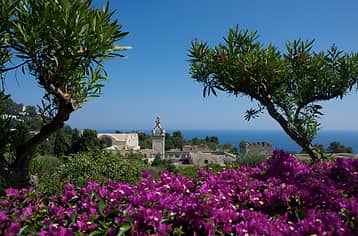- Home
- Experiences
- History of the island
History of the island

Just off the coast of Naples and Salerno, between Cape Miseno and Amalfi, a great rock soars like a dream lost in the cobalt blue sea that surrounds it. This Mediterranean jewel, yearned for and exalted in some of the world's most famous lyric poetry, is the island of Capri. The intoxicating fragrance of flowers, delicate splashes of colour, recollections of a millennial past and a peaceful charm, shattered only by the shrill cry of seagulls, are just some of the magical qualities of this mythical isle.
According to some scholars, the etymology of the name Capri may be traced back to the Greek word Kapros (wild boar). Others believe instead that Capri is derived from the Latin word Capreae (goats).
Caesar Augustus was the first to discover the charm of Capri when he visited the island in 29 BC. So taken was he with the island's beauty that he traded the nearby fertile Ischia for it with the city of Naples. This marked the beginning of Augustan rule. He was subsequently followed by his successor Tiberius who embarked on an intense building program between 27 and 37 A.D, resulting in the construction of 12 villas.
Prehistoric Capri
Excavations at the Hotel Quisisana brought to light the remains of an Elephas primigenius and Rhinoceros merckii, discoveries which marked the start of Ignazio Cerio's career as archeologist. Other important findings were made in the Grotta delle Felci in Marina Piccola, including a number of Neolithic tombs, amulets and bronzes, typical of ancient sites of worship.
Other archaeological sites which have proved important for the study of prehistoric Capri are the Grotta del Pisco, Il Limmo, Damecuta, Le Parate and the Grotta del Castiglione, this latter once containing an Ancient Roman nymphaeum. Today, the majority of the archaeological findings are conserved in Capri's Ignazio Cerio Museum, just steps away from the piazzetta.
Antiquity
Antiquity
The first inhabitants to settle in Capri were the Greek "Teleboi" who came to the island in the VIII Century BC. Today, only the fortified walls of an ancient Greek acropolis still survive as testimony to their presence on the island. In 1906 a local doctor, Ignazio Cerio, uncovered the remains of a number of prehistoric animals and stone weapons during excavation work undertaken to expand the Quisisana Hotel.
Early modern period
Early modern period
The great political events that unfolded in Naples with the consecutive rise to power of the Angevin, Aragonese, Spanish and Bourbon dynasties between the VIth and XIXth Centuries, had few repercussions on the island itself. Exposed to the threat of Muslim attack, and left to fend for themselves, the islanders' best defence was to flea their homes around the Marina and take refuge in the uplands.
With few natural resources and a population decimated by pirate raids and pestilence, the plight of the islanders was further exacerbated in the Seventeenth and Eighteenth Centuries by the rivalry that emerged between the island's two Communes, Capri and Anacapri, regarding their respective civil and ecclesiastic rights of jurisdiction.
Following the last heroic disembarkation on the island, the French completed the island's fortifications and remained there until the fall of Napoleon and the restoration of the Bourbons in 1815. It was only then that Capri finally emerged from its long hibernation, ready to embrace the romanticism of the Nineteenth Century.
Contemporary period
Contemporary period
It was in fact during this time that the island's magical solitude and rustic simplicity first began to attract visitors, and soon became the favourite seasonal haunt and residence of foreign artists, writers and poets. In 1826 Hotel Pagano, the island's first hotel, welcomed the German writer Augustus Kopisch. But it wasn't until after the Russian-Japanese war of 1905 and the great exodus of Russian intellectuals, that Capri really established itself as a literary and political refuge.
It was about this time that Maxim Gorki also arrived in Capri where he was warmly embraced into the island's cosmopolitan life. Amongst contemporary writers, two in particular enjoy pride of place in the island's literary annals: the Swede Axel Munthe and the island's own Edwin Cerio.